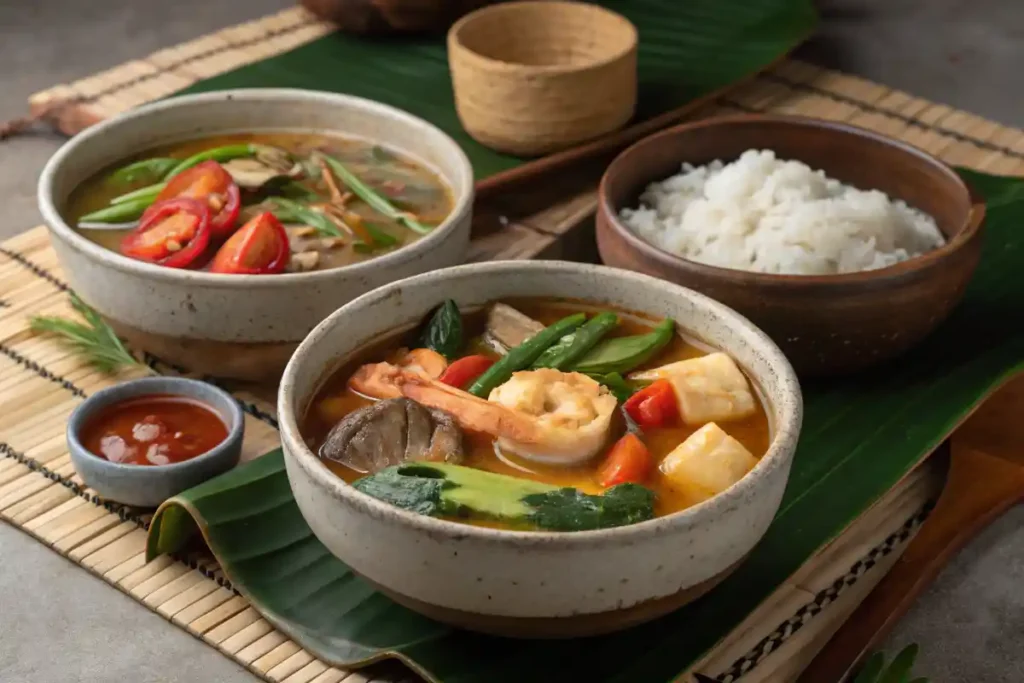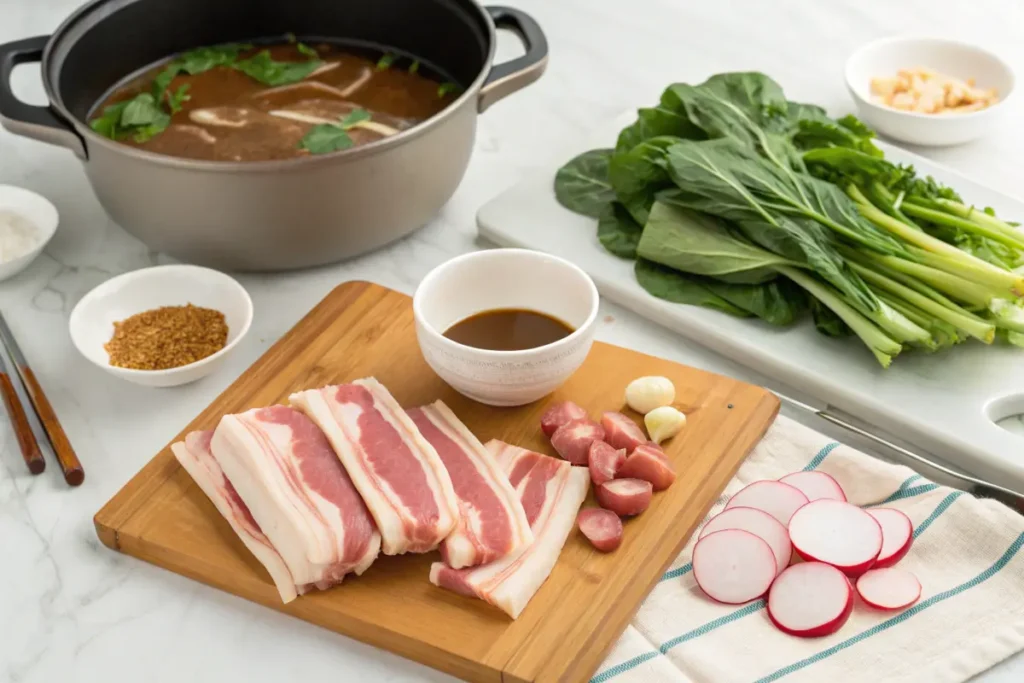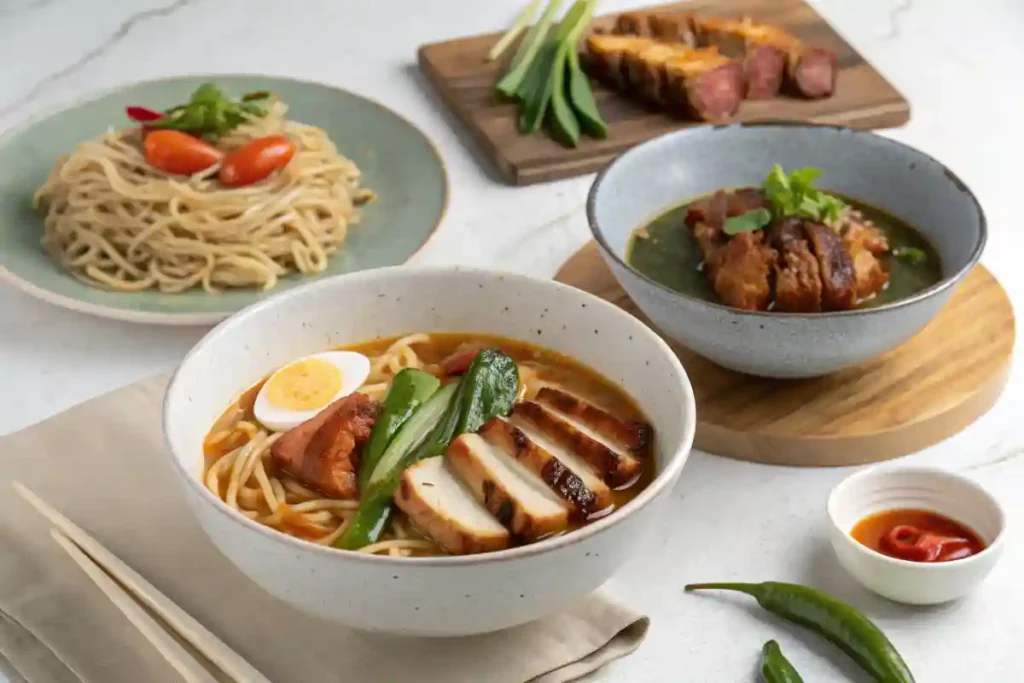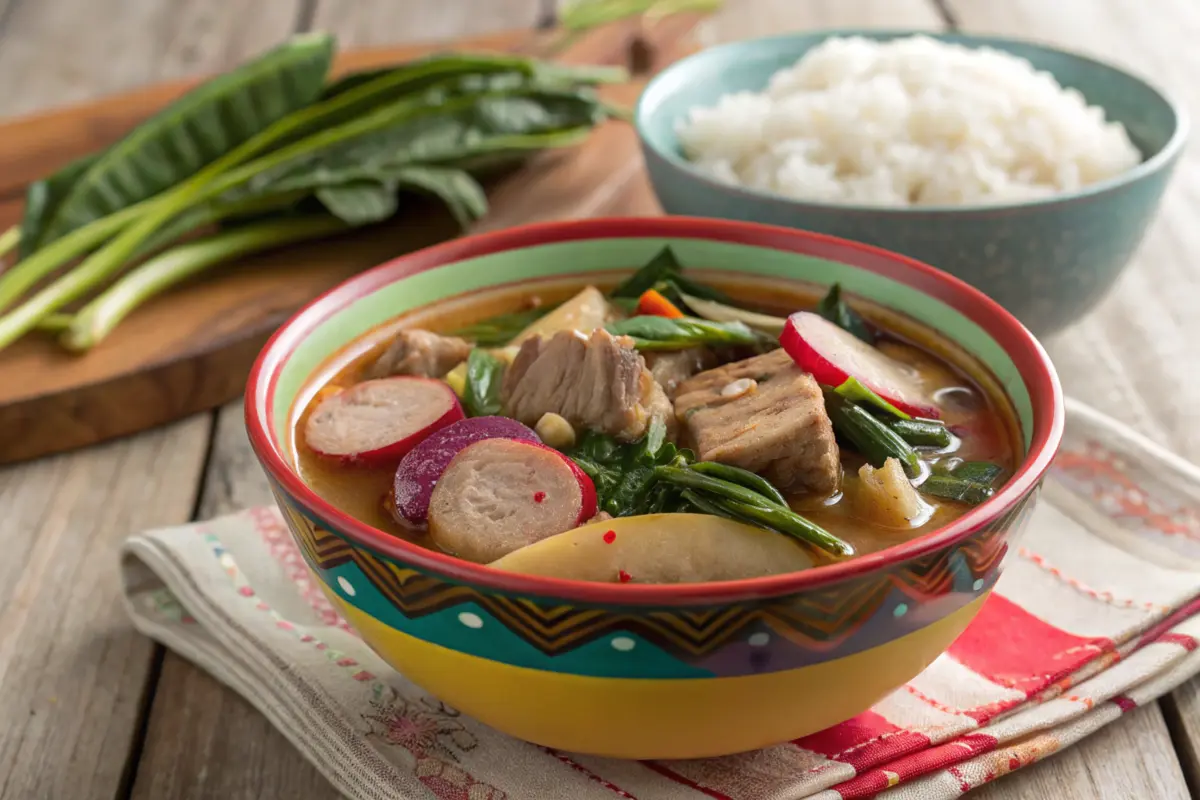Sinigang is a cornerstone of Filipino cuisine, loved for its comforting blend of sourness and savory richness. This iconic dish has captivated both locals and curious food lovers worldwide, making it a topic of intrigue for those unfamiliar with its cultural roots. But here’s the burning question: What is sinigang called in English? This article dives deep into its essence, exploring its name, flavors, ingredients, and how it reflects the heart of the Philippines.
Introduction to Sinigang
What is Sinigang?
At its core, sinigang is a traditional Filipino soup or stew known for its distinct sour taste. The sourness, typically derived from tamarind, guava, or other acidic fruits, sets it apart from other Asian dishes. It’s a versatile dish that can feature pork, fish, shrimp, or even beef as its main protein. For many Filipinos, sinigang is more than just a meal; it’s a comforting embrace in a bowl.
Its appeal lies in its simplicity and the way it captures the unique balance of Filipino flavors—tangy, savory, and sometimes spicy. Whether it’s a rainy day staple or a special occasion dish, sinigang remains a favorite across generations.
The Cultural Significance of Sinigang in Filipino Cuisine
Sinigang holds a special place in the Filipino culinary landscape. It’s not just food; it’s a cultural symbol. Often shared during family gatherings or prepared to comfort loved ones, it embodies the warmth and togetherness that Filipinos value. Its sour yet soothing flavor mirrors the Filipino spirit—resilient, adaptable, and deeply rooted in tradition.
Moreover, the dish’s ability to evolve with modern twists reflects the innovative nature of Filipino cuisine. Whether served in a traditional clay pot or reimagined in gourmet kitchens, sinigang continues to tell the story of the Philippines, one ladle at a time.
Sinigang’s English Translation and Explanation
Literal Translation: What Does “Sinigang” Mean?
In its most basic sense, the word sinigang translates to “stewed dish” in English. This description, however, only scratches the surface of what makes this Filipino soup special. Unlike typical stews, sinigang is defined by its signature sourness, often derived from tamarind (sampalok), which is a key ingredient. While the term “stew” might seem fitting at first glance, it fails to capture the unique interplay of flavors that make sinigang distinct.
In Filipino culture, the word sinigang also implies a method of cooking where ingredients are simmered together to create a flavorful broth. It’s an experiential dish that goes beyond its literal name.
Why Sinigang is Commonly Referred to as “Tamarind Soup” in English
To bridge the cultural gap, many refer to sinigang as “tamarind soup” in English. This name highlights the primary ingredient, tamarind, which gives the dish its trademark tanginess. While this term is widely accepted, it doesn’t fully encompass the variety of ingredients or the rich history behind the dish.
Interestingly, not all sinigang recipes rely on tamarind. Other souring agents, such as guava, calamansi, or even green mangoes, are sometimes used. This adaptability makes sinigang much more than just a “tamarind soup”—it’s a dynamic and deeply personal culinary tradition. For those exploring Filipino food for the first time, understanding this complexity can add depth to their appreciation of the dish.
For a deeper dive into authentic sinigang recipes, check out this Sinigang Recipe Guide for inspiration.
Ingredients That Define Sinigang
Key Ingredients: Tamarind as the Star
The heart of any sinigang lies in its souring agent, with tamarind leading the charge. Tamarind pods are boiled and strained to extract their tart juice, forming the base of the broth. This sourness not only defines the dish but also complements the savory flavors of the meat and vegetables.
However, tamarind isn’t the only option. Guava-based sinigang offers a sweeter, milder profile, while calamansi adds a citrusy zing. These variations ensure that sinigang remains a dish for all seasons and preferences.
Vegetables and Proteins Commonly Used
A typical sinigang features a medley of fresh vegetables such as eggplant, kangkong (water spinach), radish, and string beans. These vegetables not only add texture but also soak up the broth, making every bite a burst of flavor.
On the protein side, pork (sinigang na baboy) is a crowd favorite, but shrimp (sinigang na hipon), fish, and even beef are popular options. Each protein lends its unique taste to the broth, ensuring no two bowls of sinigang are ever identical.
Want to know more about the main ingredients in sinigang? Read this comprehensive guide for detailed insights.
Variations of Sinigang

Pork Sinigang (Sinigang na Baboy)
Among the many versions of sinigang, sinigang na baboy is a classic favorite. Made with tender pork belly, ribs, or shoulder, this variation is hearty and deeply satisfying. The richness of the pork perfectly balances the sourness of the tamarind broth, creating a comforting dish that’s ideal for family dinners. Adding fresh vegetables like string beans, radish, and eggplant elevates the dish’s overall flavor and nutritional value.
To experiment with more traditional flavors, try incorporating native vegetables like kangkong (water spinach) or taro. These add a delightful texture that complements the pork.
Seafood Sinigang
Seafood enthusiasts will adore sinigang na hipon (shrimp sinigang) or fish-based sinigang, often made with milkfish (bangus). These lighter variations highlight the natural sweetness of seafood, which contrasts beautifully with the sour broth. Some recipes even use clams or mussels for an extra burst of ocean flavor.
For those curious about experimenting with seafood soups, take inspiration from Filipino Seafood Recipes, which offer a range of ideas to explore.
Beef and Other Lesser-Known Variants
Beef sinigang (sinigang na baka) is another delicious twist, offering a richer, more robust flavor. It’s often paired with hearty vegetables like okra and cabbage. Less common yet equally delightful are sinigang made with chicken or exotic ingredients like corned beef.
No matter the variation, sinigang remains adaptable to ingredients on hand while retaining its sour, comforting essence.
How to Make Sinigang: A Recipe Breakdown

Step-by-Step Guide to Cooking Sinigang
Creating sinigang at home is simpler than you might think. Here’s a basic recipe for sinigang na baboy:
- Prepare the Ingredients: Gather pork (about 500g), tamarind paste, onions, tomatoes, radish, string beans, eggplant, and water spinach.
- Sauté the Aromatics: In a large pot, sauté onions and tomatoes until fragrant.
- Simmer the Pork: Add the pork and enough water to cover it. Let it simmer until the meat is tender.
- Add the Tamarind: Stir in tamarind paste or juice. Adjust to your desired level of sourness.
- Cook the Vegetables: Add the vegetables in stages, starting with the ones that take longer to cook (radish, eggplant) and finishing with water spinach.
- Season and Serve: Adjust salt to taste, and serve hot with steamed rice.
Tips for Adjusting Sourness and Flavor
- Experiment with Souring Agents: If tamarind isn’t available, use alternatives like calamansi or green mangoes.
- Balance the Broth: Add fish sauce (patis) or salt gradually to avoid overpowering the sourness.
- Enhance Umami: Include a small piece of shrimp paste (bagoong) for added depth.
If you’re eager for more guidance, check out this comprehensive Sinigang Recipe Guide to refine your cooking skills.
For even more comforting soup ideas, explore other recipes at Recipe Foodies.
Modern Takes and Global Adaptations of Sinigang

Fusion Recipes: Incorporating Sinigang in Modern Dishes
Sinigang has stepped out of the traditional pot and into innovative culinary creations, proving its versatility. Chefs around the globe have reimagined this classic dish, blending its tangy essence with modern techniques. For instance, sinigang ramen pairs the sour broth with Japanese noodles and pork chashu, creating a comforting hybrid. Similarly, some restaurants offer sinigang-inspired marinades for grilled meats, infusing the unique flavor profile into barbecue favorites.
Dessert might seem like an unlikely area for sinigang’s influence, yet tamarind sorbets or cocktails inspired by sinigang have started to appear on avant-garde menus. These creative spins showcase the dish’s adaptability to various cuisines and dining experiences.
How Sinigang is Perceived Globally
As Filipino cuisine gains global recognition, sinigang has earned its place as a standout dish. Often referred to as “Filipino tamarind soup,” this label provides international audiences with a starting point for understanding its essence. However, it leaves room for exploration, as the flavors of sinigang defy simple categorization.
Food enthusiasts worldwide appreciate sinigang for its bold, sour profile—a refreshing contrast to the typically sweet or savory flavors found in other soups. This rise in global popularity sparks curiosity, leading many to ask: What is sinigang called in English? While “tamarind soup” suffices for quick explanations, those who taste it know the name doesn’t capture its depth.
Health Benefits of Sinigang
Nutritional Benefits of Key Ingredients
Sinigang isn’t just delicious—it’s also a nutrient-packed dish. The tamarind base is rich in antioxidants and vitamins like C and B, which boost immunity and digestion. Adding vegetables like water spinach, radish, and tomatoes enhances the dish’s vitamin and fiber content, promoting gut health.
Meanwhile, the choice of protein—whether pork, fish, or shrimp—provides essential amino acids that support muscle repair and overall health. The broth, infused with these ingredients, becomes a hydrating and nourishing option, perfect for recovery after illness.
Why Sinigang is Considered Comfort Food
Beyond its health benefits, sinigang’s warm, tangy broth has earned it a reputation as a comfort food. Its ability to soothe the palate and warm the soul makes it a go-to meal during rainy days or after a stressful week. The harmony of sourness and savoriness has a way of easing both hunger and emotions.
For those wondering what is sinigang called in English, it’s more than a translation—it’s a dish that translates into comfort, tradition, and well-being for Filipinos and beyond.
Frequently Asked Questions (FAQs)
1. What is Sinigang’s Main Ingredient?
The standout ingredient in sinigang is its souring agent, with tamarind being the most iconic choice. However, other fruits like guava, calamansi, or green mangoes are sometimes used to create different flavor profiles.
2. How Does Sinigang Differ from Other Soups?
Unlike most soups that lean toward savory or creamy flavors, sinigang is defined by its unique tanginess. The sour broth, combined with fresh vegetables and a choice of protein, makes it distinct.
3. What Makes Sinigang Unique in Filipino Cuisine?
Sinigang stands out as a dish that perfectly balances sour and savory flavors. Its versatility allows it to be adapted with various proteins and vegetables, making it a staple in Filipino households.
4. Is Sinigang Always Sour?
While sinigang is known for its sourness, the intensity can vary. Chefs often adjust the level of sourness by modifying the amount of tamarind or other souring agents used.
Conclusion and Final Thoughts
What is sinigang called in English? This seemingly simple question opens the door to understanding a dish that is as rich in flavor as it is in cultural significance. Often referred to as “tamarind soup” in English, this translation only captures part of its essence. Sinigang is much more—it’s a story of tradition, innovation, and the Filipino spirit.
From its humble roots as a family meal to its modern adaptations in global cuisine, sinigang continues to evolve. Its sour, comforting broth remains a beloved choice for both Filipinos and curious foodies worldwide. With its health benefits, versatility, and comforting nature, sinigang has secured its place as a must-try dish.
Whether you’re a seasoned fan or a first-time taster, sinigang offers a culinary journey like no other. So the next time someone asks, What is sinigang called in English?, you can proudly share not just its name but also the vibrant flavors and traditions it represents.

